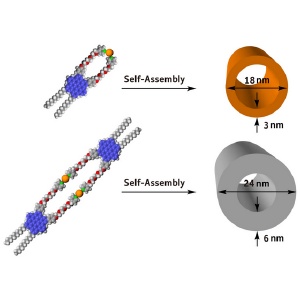Jul 23 2009
Nanoscale materials with well-defined shapes, such as one-dimensional hollow tubes, have attracted the interest of scientists seeking to utilize their unique properties. Nanotubes have large inner and outer surface areas that are accessible to many smaller molecules, meaning they have the potential to be developed into new types of sensors and catalysts.
 Two examples of nanotubular assemblies fabricated from single hexabenzocoronene amphiphile building blocks (blue/grey/red spheres) and platinum (Pt) metal ions (orange spheres).
Two examples of nanotubular assemblies fabricated from single hexabenzocoronene amphiphile building blocks (blue/grey/red spheres) and platinum (Pt) metal ions (orange spheres).
Efficient techniques to synthesize nanotubes, however, are uncommon. Now, Takuzo Aida and Takanori Fukushima of the RIKEN Advanced Science Institute in Wako and colleagues from the Japan Science and Technology Agency have developed a way to controllably self-assemble graphitic molecules and platinum metals into nanotubes with specific dimensions and structural features*.
Aida and his team used a molecule called hexabenzocoronene (HBC) as the base for their new nanotubes. Consisting of thirteen aromatic benzene rings interlocked into a large, flat cyclic structure that resembles graphite, HBC is normally used as a building block for liquid crystalline semiconductors.
In 2004, Aida, Fukushima, and colleagues discovered that by adding long hydrocarbon groups and polar chains called triethylene glycol to HBC, they could make the graphitic molecule into an amphiphile**—a surfactant that can be dissolved in organic solvents. Recrystallizing a solution of the HBC amphiphiles spontaneously produced new graphitic nanotubes.
In their latest work, the researchers incorporated platinum metals into their nanotubes structures. According to Fukushima, transition metals such as platinum can add useful catalytic, electronic, luminescent, and magnetic functionalities to the nanotubes.
In order to attach platinum metals to the nanotubes, the scientists added a molecule known as pyridine, a nitrogen-containing benzene ring, to the ends of the triethylene glycol chains on the HBC amphiphile.
“Pyridine is one of the simplest and most common molecules for binding transition metals,” explains Fukushima. “We thought it fit to use such a general binding molecule in our first attempt to functionalize the HBC nanotubes with transition metals.”
By heating a solution of the HBC amphiphiles with platinum metal ions, then allowing the mixture to cool to room temperature, the scientists observed spontaneous formation of new metal-ion-coated graphitic nanotubes. Altering the assembly conditions produced tubular assemblies with different diameters, lengths, and wall widths.
“Our nanotube can serve as a unique one-dimensional nano-scaffold with not only high structural integrity, but also with beneficial electronic properties such as energy and charge transport capabilities,” says Fukushima. “We expect that the combination of these two components might lead to unprecedented phenomenon and functions.”
*Zhang, W., Jin, W., Fukushima, T., Ishii, N. & Aida, T. Metal-ion-coated graphitic nanotubes: controlled self-assembly of a pyridyl-appended gemini-shaped hexabenzocoronene amphiphile. Angewandte Chemie International Edition 121, 4841–4844 (2009).
**Hill, J. P., Jin, W., Kosaka, A., Fukushima, T., Ichihara, H., Shimomura, T., Ito, K., Hashizume, T., Ishii, N. & Aida, T. Self-assembled hexa-peri-hexabenzocoronene graphitic nanotube. Science 304, 1481–1483 (2004).